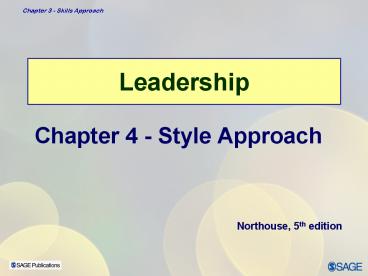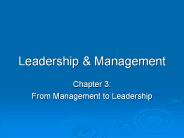Leadership - PowerPoint PPT Presentation
1 / 26
Title:
Leadership
Description:
Leadership Chapter 4 - Style Approach Northouse, 5th edition * * * * * * * * * * * * Overview Style Approach Perspective Ohio State Studies University of Michigan ... – PowerPoint PPT presentation
Number of Views:334
Avg rating:3.0/5.0
Title: Leadership
1
Leadership
Chapter 4 - Style Approach
Northouse, 5th edition
2
Overview
- Style Approach Perspective
- Ohio State Studies
- University of Michigan Studies
- Blake Moutons Leadership Grid
- How Does the Style Approach Work?
3
Style Approach Description
Perspective
Definition
- Comprised of two general kinds of Behaviors
- Task behaviors
- Facilitate goal accomplishment Help group
members achieve objectives - Relationship behaviors
- Help subordinates feel comfortable with
themselves, each other, and the situation
- Emphasizes the behavior of the leader
- Focuses exclusively on what leaders do and how
they act
4
Style Approach Description
Perspective
Definition
- Comprised of Two Kinds of Behaviors
- Task behaviors
- Facilitate goal accomplishment
- Relationship behaviors
- Help subordinates feel comfortable with
themselves, each other, and the situation
- Leader-focused perspective
- Emphasis on leaders behavior ,on what leaders do
and how they act ( style).
President
Relationship behavior
Task behavior
5
Ohio State Studies ( 1940)
- Leadership Behavior Description Questionnaire
(LBDQ) Study to analyze how individuals acted
when they were leading a group or organization. - Analysis was conducted by having subordinates
complete questionnaires about their leaders. - 150 questions of1800 items describing different
aspects of leader behavior in military,
education, social - Results - Two types of leadership behaviors
- - initiating structure task behavior
(organizing work, giving structure, defining
roles) - - consideration behavior relationship (
building trust, role model, ethical behavior.) - But which one is better? To focus on people or
task?
6
University of Michigan Studies
- Exploring leadership behavior
- Specific emphasis on impact of leadership
behavior on performance of small groups - Results - Two types of leadership behaviors
conceptualized as opposite ends of a single
continuum - Employee orientation
- Strong human relations emphasis
- Production orientation
- Stresses the technical aspects of a job
- Later studies reconceptualized behaviors as two
independent leadership orientations - possible
orientation to both at the same time
7
Blake Moutons Managerial (Leadership) Grid
- Historical Perspective
- Leadership Grid Components
- Authority-Compliance (9,1)
- Country Club Management (1,9)
- Impoverished Management (1,1)
- Middle-of-the-Road Management (5,5)
- Team Management (9,9)
- Paternalism/Maternalism (1, 9 9,1)
- Opportunism
8
Historical PerspectiveBlake Moutons
Managerial Leadership Grid
Development
Purpose
- Designed to explain how leaders help
organizations to reach their purposes - Two factors
- Concern for production
- How a leader is concerned with achieving
organizational tasks - Concern for people
- How a leader attends to the members of the
organization who are trying to achieve its goals
- Developed in early 1960s
- Used extensively in organizational training
development
9
The Leadership Grid
High
9
1, 9
9, 9
8
Country Club Management More attention to the
needs of Employees and by creating Comfortable
workplace
Team Management Focuses on work results As well
as employees Wellbeing.
7
6
5, 5
Concern for People
5
Middle-of-the-Road Balancing the necessity to
Get work done while maintain Employees
satisfactory level
4
3
Authority-Compliance Mgmt High efficiency and
unconcerned
2
Impoverished Management Low effort and unconcerned
1, 1
9, 1
1
Low
1
2
3
4
5
6
7
8
9
Low
High
Concern for Results
10
Authority-Compliance (9,1)
Definition
Role Focus
- Efficiency in operations results from arranging
conditions of work such that human interference
is minimal
- Heavy emphasis on task and job requirements and
less emphasis on people - Communicating with subordinates outside task
instructions not emphasized - Results driven - people regarded as tools to that
end - 9,1 leaders seen as controlling, demanding,
hard-driving overpowering
11
Country Club (1,9)
Definition
Role Focus
- Low concern for task accomplishment coupled with
high concern for interpersonal relationships - De-emphasizes production leaders stress the
attitudes and feelings of people - 1,9 leaders try to create a positive climate by
being agreeable, eager to help, comforting,
noncontroversial
- Thoughtful attention to the needs of people leads
to a comfortable, friendly organizational
atmosphere and work tempo
12
Impoverished (1,1)
Definition
Role Focus
- Minimal effort exerted to get work done is
appropriate to sustain organizational membership
- Leader unconcerned with both task and
interpersonal relationships - Going through the motions, but uninvolved and
withdrawn - 1,1 leaders - have little contact with followers
and are described as indifferent, noncommittal,
resigned, and apathetic
13
Middle-of-the-Road (5,5)
Definition
Role Focus
- Adequate organizational performance possible
through balancing the necessity of getting work
done while maintaining satisfactory morale
- Leaders who are compromisers have intermediate
concern for task and people who do task - To achieve equilibrium, leader avoids conflict
while emphasizing moderate levels of production
and interpersonal relationships - 5,5 leaders - described as expedient prefers the
middle ground, soft-pedals disagreement, swallows
convictions in the interest of progress
14
Team (9,9)
Definition
Role Focus
- Work accomplished through committed people
interdependence via a common stake in the
organizations purpose, which leads to
relationships of trust and respect
- Strong emphasis on both tasks and interpersonal
relationships - Promotes high degree of participation teamwork,
satisfies basic need of employee to be involved
committed to their work - 9,9 leaders - stimulates participation, acts
determined, makes priorities clear, follows
through, behaves open-mindedly and enjoys working
15
Paternalism/Maternalism
Definition
Role Focus
- Reward and approval are bestowed on people in
return for loyalty and obedience failure to
comply leads to punishment
- Leaders who use both 1,9 and 9,1 without
integrating the two - The benevolent dictator acts gracious for
purpose of goal accomplishment - Treats people as though they were disassociated
from the task
16
Opportunism
Definition
Role Focus
- People adapt and shift to any grid style needed
to gain maximum advantage
- Performance occurs according to a system of
selfish gain - Leader uses any combination of the basic five
styles for the purpose of personal advancement - Leader usually has a dominant grid style used in
most situations and a backup style that is
reverted to when under pressure
17
How Does the Style Approach Work?
- Focus of Style Approach
- Strengths
- Criticisms
- Application
18
Style Approach
Focus
Overall Scope
- Primarily a framework for assessing leadership in
a broad way, as behavior with a task and
relationship dimension
- Offers a means of assessing in a general way the
behaviors of leaders
19
Strengths
- Style Approach marked a major shift in leadership
research from exclusively trait focused to
include behaviors and actions of leaders - Broad range of studies on leadership style
validates and gives credibility to the basic
tenets of the approach - At conceptual level, a leaders style is composed
of two major types of behaviors task and
relationship - The style approach is heuristic - leaders can
learn a lot about themselves and how they come
across to others by trying to see their behaviors
in light of the task and relationship dimensions
20
Criticisms
- Research has not adequately demonstrated how
leaders styles are associated with performance
outcomes - No universal style of leadership that could be
effective in almost every situation - Implies that the most effective leadership style
is High-High style (i.e., high task/high
relationship) research finding support is limited
21
Application
- Many leadership training and development programs
are designed along the lines of the style
approach. - By assessing their own style, managers can
determine how they are perceived by others and
how they could change their behaviors to become
more effective. - The style approach applies to nearly
everything a leader does.
22
Modern View of Leadership styles
- Leadership styles have to do with how people
interact with those they seek to lead. - 1- Autocratic leadership
- 2- Democratic leadership
- 3- Participative leadership
- 4- Goal oriented leadership
- 5- Situational leadership
23
Modern View of Leadership styles
- Autocratic leadership People who take this
approach make decisions without consulting the
employees who will have to implement them or will
be affected by them - Democratic leadership People who take this
approach involve the employees who will have to
implement them or will be affected by them. The
leaders actually makes the final decision, but
only after receiving the input and
recommendations of team members.
24
Modern View of Leadership styles
- Participative leadership People who take this
approach exert little control over the
decision-making process. The leaders job to move
the team toward consensus. - Goal oriented leadership People who take this
approach ask team members to focus solely on the
goals at hand. Only a strategic goals would be
discussed within the team members, so the
influence of personalities unrelated to the
specific goals of the org is minimized.
25
Modern View of Leadership styles
- Situational leadership People who take this
approach select the style that seems to be
appropriate based on the circumstances that exit
at a given time. The leader has the choice to
choose Autocratic, democratic, participative,
or goal oriented approach , it depends on the
situation. - The appropriate leadership style in a total
quality management might be called participative
leadership style in new views. The involvement
of concerned employees comes from empowered
employees.
26
Case 4.3, page 83
- Enhancing the Departments Culture
- Answer questions 1 and 2
- Remember to answer the questions covering the two
parts - Part-1 Define the concept, theory or model
- Part-2 quote from the case study what you
believe that will support your argument.































